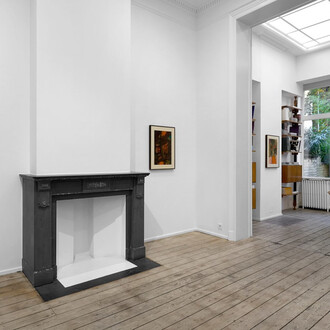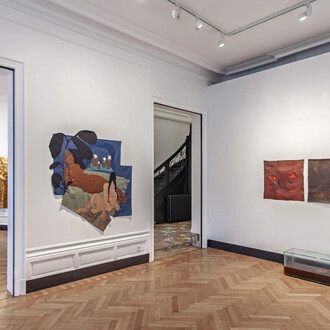Nino Mier Gallery is delighted to present Knight’s move, Asher Liftin’s second exhibition with Nino Mier Gallery, and his first presentation in Brussels. In this new body of work, comprised of paintings and works on paper, Liftin continues to explore ideas of perception, the constructed image and abstracted realism, frequently adopting the still life to represent the act of seeing. The exhibition will be on view at the gallery’s Allard 25 location in Brussels, from November 8th – December 21st, 2024.
On occasion of this exhibition, art historian Carol Armstrong wrote the following essay after visiting Liftin’s studio in Brooklyn:
He begins a painting with a canvas prepared with a medium-grey ground: neither the dark ground of old-style chiaroscural painting, nor the light ground of Impressionist “peinture claire”, but something in-between. He proceeds by projecting a digital photograph onto that prepared surface, blocking out its main forms and, crucially, the highlights on those forms, in white acrylic, before adding in dark tones that—together with the white pigment and grey ground—give the under-painting the look of a black-and-white photograph translated into paint. And then he layers over that foundation a painterly kind of rasterized dot-matrix, in successive strata of colored, water-based inks, carefully prepared on his palette to follow the CMYK (Cyan/Magenta/Yellow/Key) subtractive system of color-mixing. Together those pixelated strata construct the image—a still life, say, of a single flower in a simple glass vase—in much the same way that our eyes, in concert with our brains, construct a recognizable image, from the ground-up, out of bits of raw perceptual data: something that is going on all the time without our being in the least aware of it. Simultaneously, the highlights that undergird that colored dot-matrix—instead of sitting on top as they generally do in the history of illusionist painting—filter and flicker through to give the image, the flower in the glass vase, its optical sparkle, mimicking the additive RGB (Red/Green/Blue) system of the light spectrum, as received by the three types of light-receptor cones in the human eye, before being processed in and through the somatic activity of the brain.
As the painting’s viewers, in turn, we see that flower in the glass vase as if through a screen: a window screen, a computer screen, a silkscreen or a half-tone screen—really, any or all of these screens are pertinent here. And we start by taking that screened image in from a distance that allows us to see, recognize and understand it as a whole gestalt, processing it from the top down, before moving up close to encounter the rainbow networks of colored and sometimes gridded dots of which its surface is composed, at which point the gestalt of the flower in the vase partially unravels and undoes itself, to become an exercise in pointillist abstraction. That raveling and unraveling are complementary and continuous in the dance between painter and viewer that each of Asher Liftin’s paintings proposes.
From a distance, as if seen through a screen, the canna lily in its squat, round glass vase is a cool painting, as are all of this young artist’s paintings, when seen at a glance or in photographic reproduction. But as we move progressively closer in to its surface, it gathers warmth, not only from the coloristic pleasures of its overlapping cyans and magentas and yellows—which combine to produce greens and pinks, oranges and purples, interlaced with blacks—but also from the ever-more evident facture of the painting, in particular the drips that stream down from some of its details. Those drips, together with the woven, textile-like look of the ink-painted surface, help sustain the unraveling effect that marks these paintings as well: one small colored-pencil drawing of a lit candle metaphorizes that effect quite directly, with a bottom edge that appears to fray, as if each colored line that makes up the mesh of the image were a separate colored thread, coming apart from the lattice-work warp and weft of its weave. It is at this level that the paintings, too, confront their intermedial constructedness: their fundamental movement between the image-systems of painting, digital photography, printing, drawing—all of which are practiced by Liftin—as they are tapestried together like a loomed piece of Jacquard fabric, yielded from a proto-computer code. (The textilic basis of painting-on-canvas surfaces everywhere, across media, in this body of work).
The subjects that Liftin chooses to paint, print and draw, along with the manner in which they are rendered, are mediated—screened, we might say—through an array of art-historical reference. First, still life—flower painting, in particular—reminiscent, for me at least, of Edouard Manet’s poignantly simple “last flowers”. (There is also a lovely little drawing of lemons that reminds me irresistibly of Manet’s own late lemon and other single and double pieces of fruit.) Studio and gallery windows, printed and painted, larger and smaller, which call to mind both the modernist grid and the Italian Renaissance model of the picture-as-window, an opening onto the world on the other side of its notionally transparent surface. Small colored-pencil drawings of a female intimate, at once clearly posed and snapshot-like: these portraits evoke the photo-filtered paintings of Gerhard Richter, as does the topic of the lit candle found in certain drawings and paintings, such as the one mentioned above. Mannerist bathers, culled randomly, by means of a self-censoring prompt given to an AI program, from 17th-century Italian sources such as the work of the so-called Il passignano.
Collaged and swirled paintings that vaguely recall Picasso and Van Gogh. The illusionist gambits of 2oth-century Photorealism and of earlier camera obscura painters such as Johannes Vermeer. And through it all, of course, runs the Neo-Impressionist mark of Georges Seurat, and the divisionist color theory that goes with it. Though it is possible to see Liftin’s paintings as connecting the dots between Vermeer and Richter, however, this screening through the sieve of art history does not really yield any secure time-line; quite the contrary. But it does knit together the threads of a mediated vision, in which the image bank of painting and its sister media is imbricated with cognitive process. Asher Liftin is not a neuroscientist, and this is not “neuro-art-history”, but his is a practice that everywhere invokes the intersection between art and cognition.
I have always had a special taste for still-life painting, so I am drawn to those works in particular. One little doubled painting of flowers in a vase—on the left side a Photorealist oil version of it, and abutting it on the right side a flipped version of the same image, rendered in an enlarged raster of inked dots—opens onto broader questions of mirroring and cognitive mediation, scaling and iteration. And so, though it is not in the present exhibition, I shall conclude by zeroing in on a slightly earlier pair of paintings that resides in Liftin’s studio, for that pair quite literally doubles down on the same operation of doubling in order to confront those questions with magisterial, even preternatural confidence. Much larger in scale, this pair of paintings of tulips in a vase set against a view out a window, each reflected upside-down in the surface of a glass coffee table with books on it, flips the left-right orientation of the smaller still-life pair, so that now the rasterized, inked canvas sits on the left, hinged to the reversed, Photorealist oil version of itself on the right. This time the rasterized half on the left is composed of a tighter fabric of much smaller pixelation, so that the importance of scale and resolution become pronounced, especially relative to the smaller, more recent pair of flower paintings just mentioned: the smaller the painting the larger and more noticeable the raster, and the closer one is invited to get to the image’s surface and its mediation by and through its weave of dots, while the larger the painting and the smaller the raster, the more one is inclined to back up and see it as a resolved image. And vice versa on both counts.
But in the case of the larger pair of paintings that scalar dimension, along with the doubling and reversal of the image, the undermining of its own transparency, its translation of digital photograph into paint, and its pairing of printerly ink and painterly oil, is tied to a more complex meditation on mirroring. The still life’s setting against the backdrop of a window is pertinent here, as is the pile of books (with at least one semi-readable title on its spine); the mirror-image of the artist with camera reproduced twice on the convex side of the vase and twice reflected upside-down on the glass table (mimicking a device found in 17th-century Dutch still-life painting); the broad areas of white paint on that table in the right-side version; the blurry white “circles of confusion” on the cushions in the right-side background (subtly reminiscent of Vermeer’s work); and the little square painting-within-a-doubled-painting that is purposefully propped against the couch and the window in the back.
Together these add up to a kind of self-reflexive summa of Asher Liftin’s iterative experimentation with the relay between painting and cognition: suggesting not only the intersection between bottom-up and top-down mental processing, but also the doubling of stereoscopic vision, the upside-downness of the retinal image before it is righted by the brain, not to mention the necessity of repetition in the process of learning to see. And through it all runs the history of Western picturing, screened through the colored materiality of painterly and printerly pigment. Back up from the surface, and ta-da!, it comes into focus. Move in close, and it comes undone. Move away once more and it all comes back together. But move from side to side in front of this joined pair of paintings, and you see it do both, in concert and in oscillating alternation, over and over again.
Asher Liftin (b. 1998, New York, NY; lives and works in New Haven, CT) graduated from Yale University in 2021 with a B.S. in Cognitive Science and a B.A. in Visual Art. Liftin has held solo exhibitions at Nino Mier Gallery, New York, NY; Alessandro Albanese Gallery, Milan, IT; and Aisling Gallery, New Haven, CT. The artist has also participated in group exhibitions with all of the above as well as Venus over Manhattan, New York, NY; Winter Street Gallery, Edgartown, MA; Palo Gallery, New York, NY; MoCA Westport, Westport, CT; The Graduate Hotel, New Haven, CT. Liftin created original artwork for Wes Anderson’s major motion picture, Moonrise Kingdom, and was a 2020-21 Franke Fellow.
















